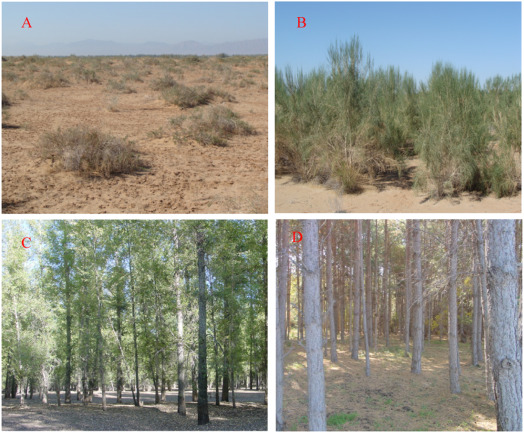The irrigated Populus simonii Carr., and Pinus sylvestris var. mongolica Litv. plantations and nonirrigated Haloxylon ammodendron plantation are the three main artificial plantations used for wind reduction and sand fixation in the oasis–desert ecotones of China's northwestern and northern regions. However, information on the soil environmental response to the establishment of these plantations is limited.
Researchers from Xishuangbanna Tropical Botanical Garden (XTBG) and University of Western Australia conducted a study to evaluate the changes in soil physical, chemical and microbiological properties after the long-term establishment of Haloxylon ammodendron, Populus simonii Carr. and Pinus sylvestris var. mongolica Litv. plantations in a Chinese oasis–desert ecotone in the central region of the Heihe River Basin.
They found that the conversion of native desert land to Populus simonii Carr. and Pinus sylvestris var. mongolica Litv. plantations significantly increased soil water-holding capacity and water-stable macroaggregation.
In contrast, the soil water-holding capacity in the Haloxylon ammodendron plantation had not increased, which was largely due to low soil macroaggregation, SOC content and fine particle content.
The poplar and pine land areas not only improved soil water-holding capacity but provided more available water for plant growth when compared to the native desert land areas and Haloxylon ammodendron plantation.
Only the Haloxylon ammodendron plantation without irrigation amended the soil microbial environment. In addition, the shrub plantation will not withstand wind erosion once it degenerates.
Taking the ecological benefits and irrigation inputs into account, the researchers recommended that complex forest systems of the artificial plantations should be designed and established in desert–oasis areas with consideration to costs and benefits.
The study entitled “The trade-off in the establishment of artificial plantations by evaluating soil properties at the margins of oases” has been published in CATENA.
Contact
LIU Changan Ph.D
Key Laboratory of Tropical Plant Resources and Sustainable Use, Xishuangbanna Tropical Botanical Garden, Chinese Academy of Sciences, Menglun 666303, Yunnan, China
E-mail: liuchangan@xtbg.ac.cn

Photographs showing the different cover types.
A: native desert land; B: Haloxylon ammodendron plantation;
C: Populus simonii Carr. plantation; D: Pinus sylvestris var. mongolica Litv. plantation
(Images by LIU Changan)

